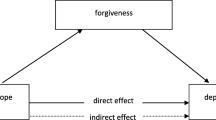Abstract
To determine the extent to which negativity about the future is specific to depression, the Hopelessness Scale (HS) scores of 199 patients diagnosed with major depressive disorder (MDD) were compared with those of 48 patients diagnosed with generalized anxiety disorder (GAD) and 76 psychiatric patients with mixed nonaffective, nonanxiety disorders. As predicted by the cognitive model, the MDD patients had higher mean HS scores than either the GAD or control patients. In addition, HS scores were more highly correlated with clinician-rated and self-report measures of depression than with measures of anxiety. Further, the positive relationships between the HS and measures of anxiety dropped to nonsignificant levels after the corresponding measures of depression were controlled for, while the HS remained correlated with depression after controlling for level of anxiety. The results were discussed as providing partial support for the content-specificity hypothesis (negative cognitive triad) of the cognitive model of depression.
Similar content being viewed by others
References
Akiskal, H. S., Hirschfeld, R. M. A., & Yerevanian, B. I. (1983). The relationship of personality to affective disorders: A critical review.Archives of General Psychiatry, 40 801–810.
American Psychiatric Association. (1980).Diagnostic and statistical manual of mental disorders (3rd ed.). Washington, DC: Author.
Beck, A. T. (1964). Thinking and depression: 2. Theory and therapy.Archives of General Psychiatry, 10 561–571.
Beck, A. T. (1967).Depression: Clinical, experimental, and theoretical aspects. New York: Hoeber.
Beck, A. T. (1976).Cognitive therapy and the emotional disorders. New York: International Universities Press.
Beck, A. T., Brown, G., Steer, R. A., Eidelson, J. I., & Riskind, J. H. (1987). Differentiating anxiety and depression: A test of the cognitive content specificity hypothesis.Journal of Abnormal Psychology, 96 179–183.
Beck, A. T., Kovacs, M., & Weissman, A. (1975). Hopelessness and suicidal behavior: An overview.Journal of the American Medical Association, 234 1146–1149.
Beck, A. T., Rush, A. J., Shaw, B., & Emery, G. (1979).Cognitive therapy of depression. New York: Guilford Press.
Beck, A. T., & Steer, R. S. (1982).The Beck Anxiety Checklist. Unpublished manuscript, University of Pennsylvania, Center for Cognitive Therapy.
Beck, A. T., Steer, R. S., & Garbin, M. (1988). The Beck Depression Inventory: Twentyfive years of evaluation.Clinical Psychology Review, 8 77–100.
Beck, A. T., Steer, R. S., Kovacs, M., & Garrison, B. (1985). Hopelessness and eventual suicide: A 10-year prospective study of patients hospitalized with suicide ideation.American Journal of Psychiatry, 142 559–563.
Beck, A. T., Vatz, K., & Winig, H. (1971).Pessimism and a sense of future time constriction as cognitive distortions in depression. Unpublished manuscript, University of Pennsylvania Center for Cognitive Therapy.
Beck, A. T., Weissman, A., & Kovacs, M. (1976). Alcoholism, hopelessness and suicidal behavior.Journal of Studies on Alcohol, 37 66–77.
Beck, A. T., Weissman, A., Lester, D., & Trexler, L. (1974). The measurement of pessimism: The Hopelessness Scale.Journal of Consulting and Clinical Psychology, 42 861–865.
Brown, G., & Harris, T. (1978).Social origins of depression. London: Tavistock Press.
Clark, D. A. (1986). Cognitive-affective interaction: A test of the “specificity” and “generality” hypotheses.Cognitive Therapy and Research, 10 607–623.
Derogatis, L. R. (1977).The SCL-90-R. Baltimore: Clinical Psychometric Research.
Dyer, J. A. T., & Kreitman, N. (1984). Hopelessness, depression and suicidal intent in parasuicide.British Journal of Psychiatry, 144 127–133.
Finlay-Jones, R., & Brown, G. W. (1981). Types of stressful life events and the onset of anxiety and depressive disorders.Psychological Medicine, 11 803–815.
Greene, S. M. (1981). Levels of measured hopelessness in the general population.British Journal of Social and Clinical Psychology, 20 11–14.
Greene, S. M., O'Mahoney, P. D., & Rungawamy, P. (1982). Levels of measured hopelessness in physically ill patients.Journal of Psychosomatic Research, 20 591–593.
Hamilton, M. (1959). The assessment of anxiety states by rating.British Journal of Medical Psychology, 32 50–55.
Hamilton, M. (1960). A rating scale for depression.Journal of Neurology and Neurosurgical Psychiatry, 23 56–61.
Lewinsohn, P. M., Steinmetz, J. L., Larson, D. W., & Franklin, J. (1981). Depression-related cognitions: Antecedents or consequence?Journal of Abnormal Psychology, 90 213–218.
Minkoff, K., Bergman, E., Beck, A. T., & Beck, R. (1973). Hopelessness, depression and attempted suicide.American Journal of Psychiatry, 130 455–459.
Petrie, K., & Chamberlain, K. (1983). Hopelessness and social desirability as moderator variables in predicting suicidal behavior.Journal of Consulting and Clinical Psychology, 51 485–487.
Rholes, W. S., Riskind, J. H., & Neville, B. (1985). The relationship of cognitions and hopelessness to depression and anxiety.Social Cognition, 3 36–50.
Riskind, J. H., Beck, A. T., Brown, G., & Steer, R. A. (1987). Taking the measure of anxiety and depression: Validity of reconstructed Hamilton scales.Journal of Nervous and Mental Disease, 175 474–479.
Rush, A. J., Beck, A. T., Kovacs, M., Weissenberger, J., & Hollon, S. D. (1982). Differential effects of cognitive therapy and pharmacotherapy on hopelessness and self concept.American Journal of Psychiatry, 139 862–866.
Stotland, E. (1969).The psychology of hope. San Francisco: Jossey-Bass.
Weissman, A., Beck, A. T., & Kovacs, M. (1979). Drug abuse, hopelessness and suicidal behavior.International Journal of the Addictions, 14 451–464.
Wetzel, R. D. (1976). Hopelessness, depression, and suicide intent.Archives of General Psychiatry, 33 1069–1073.
Author information
Authors and Affiliations
Additional information
This study, from the Foundation for Cognitive Therapy, was supported by National Institute of Mental Health Grant MH38843 to Dr. Beck.
Rights and permissions
About this article
Cite this article
Beck, A.T., Riskind, J.H., Brown, G. et al. Levels of hopelessness in DSM-III disorders: A partial test of content specificity in depression. Cogn Ther Res 12, 459–469 (1988). https://doi.org/10.1007/BF01173413
Issue Date:
DOI: https://doi.org/10.1007/BF01173413




